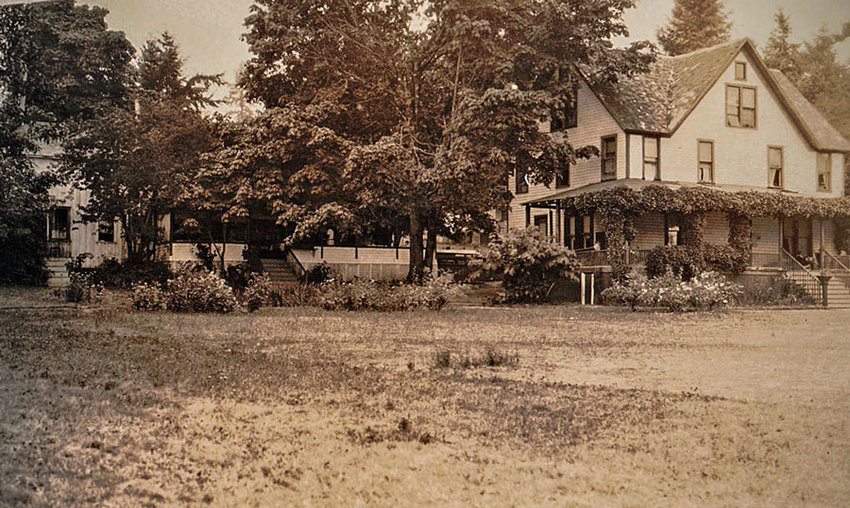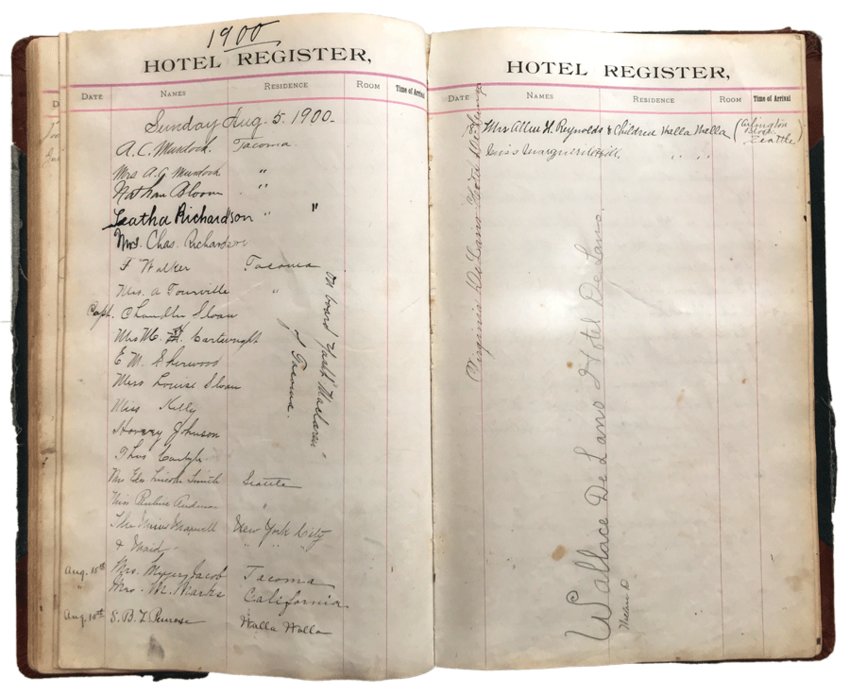 The Delano Hotel ca. 1900. Collection of Laurie W. Austin
The Delano Hotel ca. 1900. Collection of Laurie W. Austin
The beach at Delano Bay south of Penrose Point State Park extends in a graceful curve for nearly a mile. At low tide the water can peel back away from the shore for almost a quarter of a mile, exposing smooth, seemingly boundless tidal sand flats to the delight of gulls, crows or the occasional human visitor drawn to the view.
It is on the gently sloping shores of the bay that was to bear their name that Captain George Delano and his wife Edith decided to settle in 1887. It is also where they would build the storied Delano Beach Resort and Hotel, which operated from 1891 to 1948.
Settling on land must have been a difficult decision for Delano. Born in Maine in 1852, he had gone to sea at 13, eventually rising to captain and commanding merchant ships that sailed trade routes around the world. His wife, Edith H. Weeks Delano, also born in Maine, would often join him on those trips, an experience that must have become challenging once their daughter Virginia was born in 1882.
On the night of Jan. 30, 1887, the Austria, a merchant ship with Capt. Delano in charge, was caught in a powerful storm a few miles south of Cape Flattery off Washington’s Pacific coast. The ship’s three masts, no match for the gale, quickly snapped and the Austria ran aground on a reef not far from shore. Fortunately, Edith and 4-year-old Virginia had not accompanied Capt. Delano on this trip. Members of the local Ozette tribe rescued the crew and helped salvage what was left of the ship, later sold at auction.
As captain, George Delano had a financial interest in the Austria. Even after the insurance payment, however, Delano was ruined. Although he would eventually go back to sea, settling on land now must have seemed like a sensible decision.
For reasons history does not record, a few months earlier Edith Delano had bought 145 acres of waterfront property on Carr Inlet in the future Delano Bay. That was where the Delanos settled and built their first house, which was completed in 1888. Delano Hotel guest register, August 1900. Samuel Penrose’s signature is at bottom left. The Delanos’ 9-year-old son Wallace and 17-year-old daughter Virginia enjoyed signing their names on the register. Collection of Key Peninsula Historical Society. Photo: Joseph Pentheroudakis, KP News
Delano Hotel guest register, August 1900. Samuel Penrose’s signature is at bottom left. The Delanos’ 9-year-old son Wallace and 17-year-old daughter Virginia enjoyed signing their names on the register. Collection of Key Peninsula Historical Society. Photo: Joseph Pentheroudakis, KP News
In the summer of 1889 the Delanos, assisted by local fishermen and cooks, organized an enormously successful Indian-style clambake on the beach for a large group of visitors. Edith came from a long line of innkeepers in Maine; entertaining was in her blood. According to the family, the success of the clambake, combined with Edith’s background and the increasing interest in summer hotels and resorts in the Sound, led to the couple’s decision to start a resort on Delano Beach.
Two years later, in the summer of 1891, the 20-room Hotel Delano (later the Delano Beach Resort and Hotel) opened for business. Guest cottages surrounded the hotel; their number would eventually grow to 24.
The resort complex occupied about 40 acres. The grounds included pastures, a barn, orchards and chicken coops that provided fresh eggs. Several Jersey cows gave fresh milk and cream. Other supplies came from local farmers.
There were Chinese cooks, Filipino dining room servers, and housekeeping staff drawn from the surrounding area. Notably, according to family history Edith Delano did not hire anyone from Home Colony, the peaceful community of free thinkers established nearby in 1896, fearing their “communist” views.
The open dining room seated 100 with tables topped daily with vases full of flowers freshly cut from the hotel’s English gardens. From the covered porch on clear days, guests could see the top of snow-capped Mount Rainier over South Head, the narrow arm of land at the south end of the beach.
“The best hotel in the state,” newspaper ads would later boast. “Fair Delano on the Sound! Renowned for delicious eats, geoduck soup (Delano style), an Epicurean delight. Warmest bathing beach on Sound. Dancing pavilion, tennis court, boating and fishing.”
A baseball diamond, a croquet field and a putting green were also available. The accommodations may not have been luxurious, although the hotel did include indoor plumbing, but in the summer months guests probably did not spend too much time inside.
Before roads and cars, guests and visitors arrived on the Mosquito Fleet’s steamers or by private pleasure boats. In 1905 an 830-foot long pier with a floating dock at the end replaced the floating dock at the beach; it extended past the shallow part of the beach at low tide, allowing ships to dock at any time. Some of the pilings can still be seen at low tide.
The crossing from Tacoma by commercial steamer could easily take three to four hours, since the boats made several stops along the way; a trip from Seattle added three hours. Edith would always greet new arrivals at the dock, and many of the guests would join her.
Hotel registers still in the family’s collection show that most guests came from Tacoma, but visitors from Seattle and points beyond were not uncommon. A notable guest in August 1900 was Samuel L. B. Penrose, early president of Whitman College in Walla Walla. In October 1901 Penrose bought the 6.75 acres that the Delanos owned at Prospect Point, the northeast tip of what is now Penrose Point State Park.
George went back to sea in 1894 and died in Portland in 1913. The resort operated without interruption every summer for several decades under Edith’s stewardship, surviving (at times barely) downturns in the economy and the disruptions caused by world events.
Following Edith’s death at 70 in 1932, her daughter Virginia Slocum, who lived in Portland, hired managers and caretakers to operate the resort. In 1948 the property was leased and later sold to the Ollar family; the Ollars closed the hotel but continued to rent a few of the cottages. The old hotel fell into disrepair and was demolished in 1972.
In 1973 the property was acquired by Stan and Marlene Granberg. Guest registers show they rented the remaining cottages until 1976. In 1979 the Granbergs donated the compound to The Church of Christ, which owns and operates the Delano Bay Christian Camp to this day. The current camp lodge and dining hall stand on the site of the old hotel, offering the same unspoiled views as the original Delano Hotel.
Several descendants of George and Edith Delano continue to own property on Delano Beach, as do a few families who had once been guests at the resort. A handful of the waterfront cottages and some of the resort’s outbuildings still stand on the camp’s grounds, reminders of the unbroken strands of our connection to the past.
Many thanks to Laurie W. Austin, Cathy Williams and the Key Peninsula Historical Society for their assistance with research for this article.
UNDERWRITTEN BY THE FUND FOR NONPROFIT NEWS (NEWSMATCH) AT THE MIAMI FOUNDATION, THE ANGEL GUILD, ADVERTISERS, DONORS AND PEOPLE WHO SUPPORT INDEPENDENT, NONPROFIT LOCAL NEWS